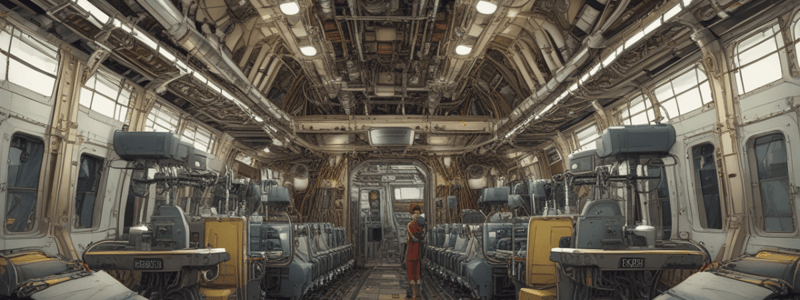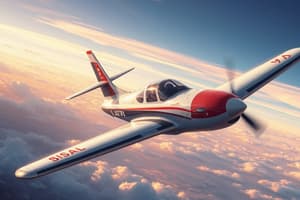Podcast
Questions and Answers
What is the primary consideration when testing electrical bonding in aircraft?
What is the primary consideration when testing electrical bonding in aircraft?
- The specific requirements detailed in aircraft or component publications (correct)
- The length of the braid used in bonding
- The resistance of the bonding jumper
- The type of paint used on the aircraft
What should be removed or pierced before testing electrical bonding?
What should be removed or pierced before testing electrical bonding?
- RF components
- Cadmium and tin plate
- Protective treatments such as priming and finishing paints (correct)
- Bonding jumpers
What is the maximum resistance required for general electrical bonding?
What is the maximum resistance required for general electrical bonding?
- 0.05 Ω
- 0.025 Ω
- 0.1 Ω (correct)
- 0.0025 Ω
What is the reference standard for bonding of RF components?
What is the reference standard for bonding of RF components?
What is the maximum length of braid used in bonding to moving parts?
What is the maximum length of braid used in bonding to moving parts?
What is the purpose of forming a leak-proof joint at the end connections of flexible fuel pipes?
What is the purpose of forming a leak-proof joint at the end connections of flexible fuel pipes?
What is the maximum resistance allowed for bonding between components and main earth?
What is the maximum resistance allowed for bonding between components and main earth?
What is the maximum resistance allowed for bonding between extremities of the aircraft?
What is the maximum resistance allowed for bonding between extremities of the aircraft?
What is the purpose of the colour-coding on pre-insulated terminals?
What is the purpose of the colour-coding on pre-insulated terminals?
What is the minimum wire gauge size that can be terminated with a terminal having yellow insulation?
What is the minimum wire gauge size that can be terminated with a terminal having yellow insulation?
What is the purpose of the self-locking ratchet mechanism in approved hand crimping tools?
What is the purpose of the self-locking ratchet mechanism in approved hand crimping tools?
What is the range of wire sizes that can be crimped using the M22520/5 tool?
What is the range of wire sizes that can be crimped using the M22520/5 tool?
What is the purpose of the removable dies in the M22520/5-01 and M22520/10-01 tools?
What is the purpose of the removable dies in the M22520/5-01 and M22520/10-01 tools?
How are the crimping dies retained in the tool frame?
How are the crimping dies retained in the tool frame?
What is the purpose of the hexagonal crimp dies?
What is the purpose of the hexagonal crimp dies?
Why should the self-locking ratchet mechanism never be disassembled?
Why should the self-locking ratchet mechanism never be disassembled?
What is a common feature among all MIL-DTL-22520 hand-operated tools?
What is a common feature among all MIL-DTL-22520 hand-operated tools?
What is the primary function of the indenters in the M22520/1-01 crimping tool?
What is the primary function of the indenters in the M22520/1-01 crimping tool?
What is the purpose of the provision for selecting the proper depth of crimp in the M22520/1-01 crimping tool?
What is the purpose of the provision for selecting the proper depth of crimp in the M22520/1-01 crimping tool?
What is unique about the M22520/4-01 crimping tool?
What is unique about the M22520/4-01 crimping tool?
What type of contacts can be crimped using the M22520/2-01 crimping tool?
What type of contacts can be crimped using the M22520/2-01 crimping tool?
What is the primary application of the M22520/4 crimping tool?
What is the primary application of the M22520/4 crimping tool?
What is a characteristic of the indenters in the M22520/1-01 crimping tool?
What is a characteristic of the indenters in the M22520/1-01 crimping tool?
What is a common aspect of the M22520/1-01 and M22520/2-01 crimping tools?
What is a common aspect of the M22520/1-01 and M22520/2-01 crimping tools?
What does a larger AWG number represent in an aircraft wire?
What does a larger AWG number represent in an aircraft wire?
What is the cross-sectional area of a round conductor measured in?
What is the cross-sectional area of a round conductor measured in?
What is the unit of measure for square or rectangular conductors?
What is the unit of measure for square or rectangular conductors?
How is the cross-sectional area of a round conductor calculated?
How is the cross-sectional area of a round conductor calculated?
What is the purpose of a wire gauge?
What is the purpose of a wire gauge?
What is the smallest size wire normally used in aircraft?
What is the smallest size wire normally used in aircraft?
What is the purpose of the white end of the rear-release connector contact insertion/removal tool?
What is the purpose of the white end of the rear-release connector contact insertion/removal tool?
What is a characteristic of rear-release connectors?
What is a characteristic of rear-release connectors?
What is the diameter of a 22-gauge wire?
What is the diameter of a 22-gauge wire?
What is the relationship between 1 circular mil and 1 square mil?
What is the relationship between 1 circular mil and 1 square mil?
What is the benefit of using rear-release connectors?
What is the benefit of using rear-release connectors?
What is the purpose of the conductor channel and serrations in the insertion/removal tool?
What is the purpose of the conductor channel and serrations in the insertion/removal tool?
What is the colour coding typically used for in rear-release connectors?
What is the colour coding typically used for in rear-release connectors?
What is the correct sequence of actions to remove a contact from a rear-release connector?
What is the correct sequence of actions to remove a contact from a rear-release connector?
What is the advantage of using plastic insertion and removal tools?
What is the advantage of using plastic insertion and removal tools?
What is the purpose of the red end of the rear-release connector contact insertion/removal tool?
What is the purpose of the red end of the rear-release connector contact insertion/removal tool?
Study Notes
Aircraft Electromagnetic Bonding and Wiring Practices
- Remove or pierce protective treatments (e.g. priming and finishing paints, varnishes, chromic, anodic, and phosphate coatings) before testing, except for cadmium and tin plate.
- Connect the single-prong probe of the 60-ft static lead to an airframe earth point.
Electrical Bonding Requirements
- The resistance across a bonding or grounding jumper should be 0.1 Ω or less for general electrical bonding.
- For RF components, the resistance should be a maximum of 0.0025 Ω (2.5 mΩ).
Bonding Resistance Checks
- Check the resistance between cleaned areas of the object and the structure after mechanical connection is completed.
- Ensure bonding resistance between extremities of the aircraft is within the manufacturer’s limits (not to exceed 0.05 Ω [50 mΩ] on all-metal aircraft).
- When checking bonding between components and main earth, the resistance should not exceed 0.05 Ω (mid-scale deflection).
Bonding Jumpers and Flexible Fuel Pipes
- Bonds to moving parts should be made of braid (maximum length 12 in.) connected by bolts or clamps with only sufficient slack for working purposes.
- Flexible fuel pipes are bonded internally, and the resistance should not exceed 0.025 Ω/ft length or 0.05 Ω (50 mΩ), whichever is greater.
Crimping Tools and Terminal Lugs
- Use only tools qualified to MIL-DTL-22520 for crimping terminal lugs.
- Colour-coded terminal lugs or splices are used to identify wire sizes.
- Examples of crimping tools include M22520/5, M22520/10, and M22520/1-01.
Rear Release Connectors
- Rear release connectors have a blue band around the shell (body) of the connector and utilise insert lock retention.
- Removal tools must be put over the wire and inserted through an insert (grommet) to release the contact.
- Rear release pins and sockets are widely used in aircraft connectors.
Wire Size and Measurement
- Aircraft wire is measured by the AWG system, with larger numbers representing smaller wires.
- The smallest size wire normally used in aircraft is 22-gauge wire, with a diameter of about 0.025 in.
- Circular mil (cmil) is the standard measurement of a round conductor’s cross-sectional area.
- Square mil is the unit of measure for square or rectangular conductors such as bus bars.
Studying That Suits You
Use AI to generate personalized quizzes and flashcards to suit your learning preferences.
Related Documents
Description
This quiz covers the specific regulations and guidelines for aircraft wiring and bonding, including procedures for testing and safety protocols. It references AC 21-99 Aircraft Wiring and Bonding Sect 2 Chapter 13. Topics include removing protective treatments and connecting static leads to airframe earth points.




